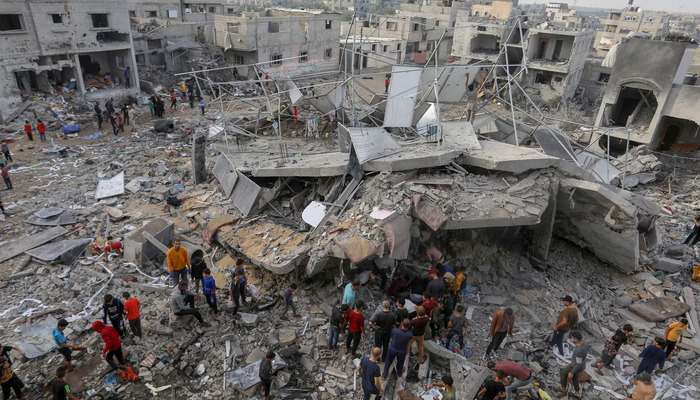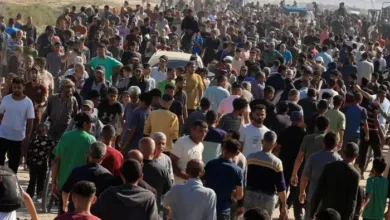
GAZA – The humanitarian situation in Gaza continues to deteriorate as Israeli air strikes killed two Palestinian women in the al-Mawasi area of southern Gaza on Sunday. The victims were sheltering in what was officially designated by the Israeli army as a “safe zone.”
The strike targeted a tent camp for displaced families, many of whom had previously fled bombardments in Rafah and Khan Younis. Local reporters on the ground confirmed that the attack left several others injured, some critically.
This isn’t the first time Israel has attacked the al-Mawasi area. Despite Israel’s declaration that it serves as a civilian refuge, strikes there have been repeated and deadly.
Meanwhile, the death toll from a separate Israeli strike on Nuseirat refugee camp has risen to 20, according to health officials in central Gaza. Hospitals in Deir al-Balah and surrounding areas are overwhelmed, with survivors describing scenes of panic and chaos as rescue workers searched for bodies in the rubble.
In a scathing critique, Israeli opposition leader Yair Lapid has denounced Prime Minister Benjamin Netanyahu’s plan to establish a so-called “humanitarian city” in Rafah for Gaza’s entire population, calling it a political stunt driven by extremist coalition partners.
Lapid, speaking to Israeli newspaper Haaretz, slammed the $4.5 billion proposal and said, “Instead of stealing the middle class’s money, end the war and return the hostages.”
The plan, spearheaded by Finance Minister Bezalel Smotrich and National Security Minister Itamar Ben-Gvir, would house over 2.1 million Palestinians on the ruins of Rafah. Critics have labeled the initiative as not just unrealistic but dangerous.
Rights groups, international watchdogs, and several governments have condemned the plan, saying it lays the groundwork for ethnic cleansing under the guise of humanitarian relief. They argue the mass relocation would effectively erase Palestinian presence from key areas of Gaza, especially in the southern corridor.
Inside Gaza, the healthcare system is in ruins. In Khan Younis, near Nasser Hospital, residents hear daily pleas for blood donations blasted through loudspeakers. Victims of both air strikes and ground fire are overwhelming the few remaining functioning hospitals.
Donya Abu Sitta, a local resident, described how even aid seekers are being shot by Israeli forces at distribution points. “It’s been like this for over a year,” she said. “People are bleeding out at hospital gates.”
Since May, dozens have died at food queues, and many of the dead were already malnourished. As Gaza runs out of medicine, clean water, and blood supplies, the medical emergency is compounding the humanitarian disaster.
Doctors Without Borders and the WHO have reported that Gaza’s health infrastructure has collapsed, with little chance of recovery unless an immediate and sustained ceasefire is implemented.
Major Twist in Humaira Asghar Death Case: Court Petition Alleges Murder
Ceasefire Talks Stall as Israel Demands Control Over Rafah
Efforts to reach a ceasefire agreement have stalled once again. According to Al Jazeera’s correspondent Nour Odeh reporting from Amman, Jordan, Israeli negotiators remain adamant about retaining full military control over Rafah and the Morag Corridor—a key strip connecting the southern edge of Gaza to the rest of the territory.
Palestinian factions, including Hamas, have rejected these terms, arguing that such demands legitimize Israel’s occupation and pave the way for mass expulsion.
US envoy Steve Witkoff had earlier urged both sides to bypass stumbling blocks and move toward implementation. However, without an agreed framework, negotiations remain paralyzed.
Meanwhile, Israel’s refusal to back away from strategic areas like Rafah continues to alarm international observers who fear the country is laying the groundwork for permanent displacement of Palestinians from Gaza.
A Humanitarian Collapse with No End in Sight
The ground reality in Gaza tells a story of unfolding catastrophe. Families continue to flee, only to find themselves targeted in supposed safe zones. Camps like those in al-Mawasi, once declared protected areas, are now frequent targets.
As the world debates diplomacy and reconstruction plans, the people of Gaza are running out of time—and out of places to hide. The war has left nearly 70% of the population displaced, and every air strike brings new funerals, new trauma, and more shattered lives.
Without a concrete ceasefire and international pressure to halt attacks on civilians, the cycle of displacement and death will continue, deepening one of the world’s worst humanitarian crises.
Follow us on Instagram, YouTube, Facebook,, X and TikTok for latest updates




